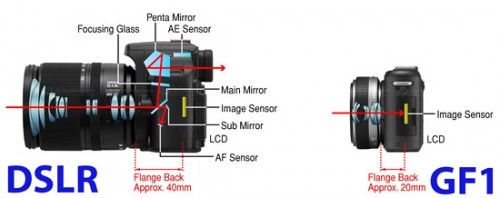Q and A: What’s the deal with the new cameras lacking pentaprisms and reflex mirrors?
Question
What is the advantage of the new cameras without a pentraprism and a reflex mirror … like the Micro models from Panasonic and Olympus, and the Samsung NX? Is the benefit simply smaller size versus a Digital SLR? In that case, why wouldn’t someone just buy a smaller camera like the Canon Powershot G11 which also has a built-in viewfinder? R.N.
Answer
The primary appeal of the “mirrorless” or “non-reflex” cameras – and their new petite lenses – is certainly the greater portability. Of course there are some intangibles as well with the latest Micro Four-Thirds cameras: the Lumix GF1 and particularly the Olympus E-P1 and E-P2. These models are very classy and they feature rangefinder-like styling, which appeals to many camera buyers. (See my Olympus E-P1 Review: Field Test Report ) But let’s discuss some of the other important aspects to clarify additional issues.
